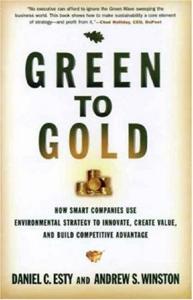
Want to learn the ideas in Green to Gold better than ever? Read the world’s #1 book summary of Green to Gold by Daniel C. Esty, Andrew S. Winston here.
Read a brief 1-Page Summary or watch video summaries curated by our expert team. Note: this book guide is not affiliated with or endorsed by the publisher or author, and we always encourage you to purchase and read the full book.
Video Summaries of Green to Gold
We’ve scoured the Internet for the very best videos on Green to Gold, from high-quality videos summaries to interviews or commentary by Daniel C. Esty, Andrew S. Winston.
1-Page Summary of Green to Gold
Sony’s Nightmare Before Christmas
Christmas is a time for festivities, but in 2001 Sony executives were worrying about cadmium. The Netherlands had impounded one million PlayStations because they contained too much of the element cadmium, which is illegal there. It was an expensive mistake that led to a new system that improved supply chain management and made Sony more competitive. Other companies have learned from this as well and now use environmental responsibility as their comparative advantage over other businesses.
Causes of the “Green Wave”
Companies are facing two pressures to go green. The first pressure comes from the physical world, which is an asset that makes economic life possible. Businesses will feel the effects of ten major environmental problems in the short and medium terms: climate change, changing energy sources, water quality and quantity, biodiversity, toxic substances and chemicals, air pollution; waste management; ozone depletion; ocean health; deforestation. Make sure you know which of these issues affect your business.
Scientific data shows that there are serious problems with the environment. Even if you don’t believe in scientific evidence, remember that many influential people do, and they’re pushing companies to catch the “green wave.” There are five major groups of stakeholders:
There are three groups of people that can help you spread your ideas: 1. Governments and NGOs, 2. Traditional media, academics and think tanks, 3. Industry associations and your suppliers or buyers and your peers.
Customers, green activists and local communities are important to the success of a business. The investors and risk assessors need to be taken into consideration as well.
The Green Playbook
These pressures create opportunities to compete by running green plays. How? By reducing waste disposal fees and decreasing regulatory fines, as well as bringing new products to market that enhance brand value. Some of these plays are more speculative than others, but they all work if you run them. If your competitors aren’t running these plays, then you should be.
The first step to improving your business is by improving the use of resources. This can be done by re-engineering systems and saving money on energy costs. It’s also important to reduce pollution that you’re causing, such as cutting down on fuel usage or preventing certain problems from occurring in the first place. The fourth way to improve your business is by staying ahead of regulations and laws so that you can comply with them before anyone else does.
The fifth play is to make products that environmentally conscious customers want. The sixth play is to show off your green bona fides, thus increasing public approval and brand loyalty. Display “eco-labels” on your products (Energy Star in the U.S., the European Eco-Label and others in the EU). The seventh play can be captured in two words: “Toyota Prius.” To use it, innovate; bet on next generation, environment-friendly products – even if they don’t fit your existing product categories. Who’d heard of “hybrid” before the Prius? The eighth play puts a “green halo” over your company. Look at what BP is doing with its “Beyond Petroleum” initiative or at GE’s “Ecomagination” campaign. Even when BP suffered a PR disaster at a Texas refinery, its image remained largely untainted.”
Running the Plays
To be successful, you need to look at your business through a green lens. This means looking beyond the trees and seeing the forest as well. You should consider opportunities up and down your value chain, think about longer-term payoffs rather than short-terms ones, start green initiatives at the top of your organization (senior management must commit), inspire people with big challenges, remember that “feelings are facts,” do what’s right instead of what’s easy or convenient (for instance, sinking an oil rig in an environmentally safe way even though it would have been easier to just sink it).





